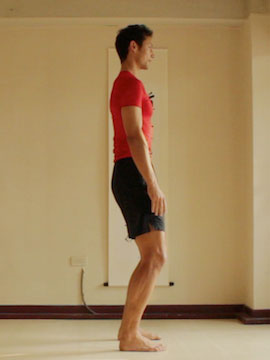Standing Meditation
Feeling Your Body While Standing Still
This standing meditation is a basic sensing exercise that can lead into learning to sense your bones and muscles. It can also be used to practice feeling your body. And it can be used as a basis for a meridian meditation or chakra meditation.
Noticing your relationship with gravity
While doing a standing meditation you have to be aware of your relationship with gravity. So that you stay upright with a minimum of physical effort you can focus on aligning your bones with gravity so that it is as easy as possible to relax your muscles.
As you stand you can scan your awareness up and down your body and as you do so you can bring your awareness to key areas, joints, muscles, energy centers or energy lines.
You may find that the more aware you are the easier it is to relax and the more you relax the more aware you become. Another benefit of standing and scanning your body is that you can build a mental map of your body. You can use this map to help you feel your body, control it and use it to both handle change and create it.
Standing Meditation Instructions
The following instructions for doing a standing meditation are ideally to help you stand while being as relaxed as possible. You will more than likely have to repeat this process a few times since every time you adjust one part of your body you'll affect other parts. However, each time you adjust your body, you'll ideally be closer to being more vertical and more relaxed.
The idea, as mentioned, is to align your bones with gravity so that your muscles can relax. If you find that a particularly adjustment is causing muscles to tense instead of relax, change the adjustment.
Also, so that it is easier to sense the effects of each adjustment, move your body slowly and smoothly. This takes control and awareness which, ironically enough, can help you to enter a meditative state of mind.
Setting up and adjusting your foot position
Stand with your feet about hip width apart with your second toes pointing straight ahead.
Activate your feet and ankles so that the front of your shins (and knee caps) point straight ahead. At the same time use this action to push the outer edges of your feet into the floor.
Push the base of your big toe down. Notice the feeling in your ankles as you do this.
Feel your heel bones lining up vertically. Keep this "activation" and shift your weight on to your heels. Feel all of your body weight pressing down through your heels as if you were wearing high heels (really pointy stilettos) and you are digging your heels in (like the once famous poster of somebody with really nice legs and high heels stubbing a cigarette out with her heel.)
If they aren't already bent, bend your knees slightly. Keep your weight on your heels.
(You can also stand with your knees straight. Choose whichever position feels most comfortable. If straightening your knees pulls on the front of your lower back, then I'd suggest keeping them bent.)
Adjusting the position of your Center of Gravity
Shift your weight back just far enough that your heels dig in but so that the fronts of your feet still stay in contact with the floor.
Adjusting your Pelvis
Roll your pelvis backwards so that your pubic bone lifts and your lumbar spine straightens. Try to use your lower belly to do this. Focus on pulling your pubic bone in and up. Try to relax your butt muscles as you do this (or keep them relaxed.)
Adjusting your ribcage
Bulge the back of your ribcage slightly and lift your back ribs.
Pull the back of your head up and back so that your neck lengthens. Make the back of your neck "feel long". Use this action to help lift the front of your ribcage slightly. Now allow the front of your ribcage to sink down just a little-enough so that you can feel the weight of the front of your ribs sinking down but not enough that you chest collapses.
Look for a nice open feeling in the front and back of your ribcage.
Adjusting your shoulders
Move your shoulder blades away from your spine. This will cause your shoulders and the outer edges of your collar bones to move forwards. It may also make your upper back feel "open." Roll your upper arms inwards a little bit and then outwards. Position them so that the front of your shoulders feel open. Keep the back of your shoulders feeling open at the same time.
Adjusting the hang of your arms
Relax the muscles of your upper arms (front and back) so that you elbows "fall" open and your lower arms can hang down.
Relax the muscles of your forearm, wrist and hands so that your palms and fingers are relaxed. Allow your fingers to hang down. Relax your fingers and your toes.
Repeating the body scanning process
Run through this checklist a few more times so that your entire body feels comfortable, open and relaxed.
Using the standing meditation to focus on bones, muscles, meridians or simply on being still
Once you are aligned with gravity and as relaxed as possible, you can use this standing meditation to focus on feeling your bones, your muscles, your meridians or your chakras. You can also simply focus on being still.
Published: 2011 04 02



